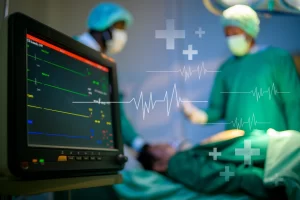
Recent Post
 Could You Recognise the Signs That Someone Needs a Defibrillator?
Could You Recognise the Signs That Someone Needs a Defibrillator?
September 12, 2023
Imagine being at the heart of a life-saving event, where mere seconds can determine the future. That’s the significance of defibrillation. In this article, we’re not merely touching upon its surface; we’re delving deep to decode the electrical essence of this life-saving process.
Historical Context of Defibrillation
Journeying back in time, our ancestors made rudimentary attempts at reviving the heart. With the progress of science, the emergence of the defibrillator as a crucial medical device was inevitable. From being rudimentary instruments to the sophisticated devices of today, defibrillators have seen a sea change.
What is Defibrillation?
At its core, defibrillation is about sending a potent electric current to the heart. This electrical jolt helps in restoring a normal heartbeat. But here’s the kicker – it’s not just any random shock; it’s a meticulously calculated dose, distinct from other methods such as cardioversion.
The Heart’s Electrical System
The heart isn’t just about thumps and beats. It’s a marvel, with its natural pacemaker and intricate electrical pathways. Every throb you feel is an outcome of precise electrical impulses, maintaining the rhythm that’s vital for life.
Ventricular Fibrillation: The Sudden Disrupter
Ever heard of Ventricular Fibrillation (VF)? It’s that rogue rhythm turning the heart’s lower chambers into a frenzy. This chaotic rhythm, if not treated promptly, can lead to dreaded cardiac arrest, a silence no one wishes for.
Electrical Properties Behind Defibrillation
When it comes to defibrillation, it’s all about the perfect trifecta:
- Voltage and Current: The dynamic duo that decides the intensity of the shock.
- Capacitance: Think of it as the heart’s energy reserve, gearing up for the big jolt.
- Circuitry: It’s what ensures the shock travels where it’s supposed to, right to the heart’s core.
Steps in the Defibrillation Process
- Patient Assessment: The first critical step, akin to reading a book’s blurb before diving into its pages.
- Positioning of Electrodes: It’s not about slap and go; it’s about strategic placement for maximum impact.
- Energy Determination: Not too little, not too much – just the right spark to kickstart the heart.
- Delivering the Shock: With everything in place, it’s time for the life-saving jolt.
Modern-day Defibrillators: Cutting-edge Lifesavers
From manual behemoths to compact Automated External Defibrillators (AEDs), the journey has been nothing short of revolutionary. The blend of innovation and urgency has birthed devices that are user-friendly, enabling even a layperson to potentially save a life. Remember, in the world of defibrillators, time is of the essence.
Challenges and Considerations in Defibrillation
Every silver lining has its cloud. While defibrillation is a boon, it comes with its bag of challenges.
- Potential complications, including minor burns or skin irritation.
- A myriad of factors that influence success rates.
- The paramount need for safety precautions is because, at the end of the day, it’s about saving lives without causing additional harm.
Conclusion
In the tapestry of medical miracles, defibrillation stands out as an intricate yet fascinating thread. It’s not just about applying a shock; it’s a culmination of science, precision, and timely intervention. And speaking of timely interventions, for over two decades, Priority First Aid has stood as a beacon of trust and reliability. As leaders in the medical industry, we don’t just provide equipment; we deliver assurance and peace of mind. With our extensive range of defibrillators and medical equipment, you’re not just choosing a product; you’re choosing experience, expertise, and excellence.






